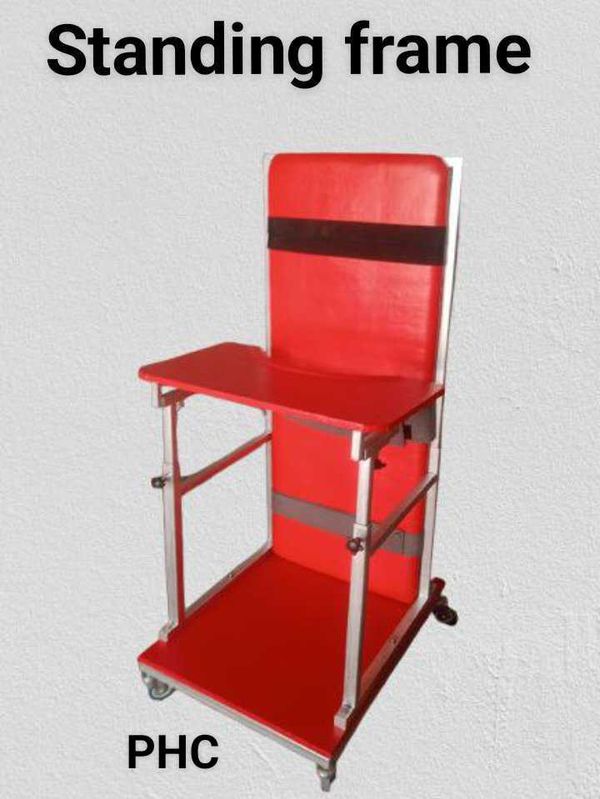Standing Frame CP
A standing frame is an assistive device designed to support individuals in a standing or upright weight-bearing position, especially those with limited mobility or who are unable to stand independently due to neurological, muscular, or skeletal conditions. It helps improve posture, circulation, digestion, and bone density by facilitating regular standing sessions.Key features typically include:Adjustable frame: Allows for customization to suit different body sizes and support needsSupportive padding: Cushions at the chest, pelvis, knees, and feet for comfort and stabilityStraps or harnesses: Secure the user safely during useWheels or casters (optional): For easy mobility and repositioningTilting mechanism (in some models): Allows for gradual transition from sitting to standing (sit-to-stand or supine-to-stand)Types of standing frames:Passive/Static: Keeps the user in a fixed standing positionActive/Dynamic: Allows movement, often with mobile bases or mechanisms for shifting weightSit-to-Stand: Assists users in transitioning from sitting to standing with mechanical or powered aidStanding frames are commonly used in rehabilitation centers, schools, hospitals, and homes, especially for individuals with conditions like spinal cord injuries, cerebral palsy, muscular dystrophy, or multiple sclerosis.
PHYSIO HEALTH CARE
All products

A standing frame is an assistive device designed to support individuals in a standing or upright weight-bearing position, especially those with limited mobility or who are unable to stand independently due to neurological, muscular, or skeletal conditions. It helps improve posture, circulation, digestion, and bone density by facilitating regular standing sessions.
Key features typically include:
- Adjustable frame: Allows for customization to suit different body sizes and support needs
- Supportive padding: Cushions at the chest, pelvis, knees, and feet for comfort and stability
- Straps or harnesses: Secure the user safely during use
- Wheels or casters (optional): For easy mobility and repositioning
- Tilting mechanism (in some models): Allows for gradual transition from sitting to standing (sit-to-stand or supine-to-stand)
Types of standing frames:
- Passive/Static: Keeps the user in a fixed standing position
- Active/Dynamic: Allows movement, often with mobile bases or mechanisms for shifting weight
- Sit-to-Stand: Assists users in transitioning from sitting to standing with mechanical or powered aid
Standing frames are commonly used in rehabilitation centers, schools, hospitals, and homes, especially for individuals with conditions like spinal cord injuries, cerebral palsy, muscular dystrophy, or multiple sclerosis.
Standing Frame CP
A standing frame is an assistive device designed to support individuals in a standing or upright weight-bearing position, especially those with limited mobility or who are unable to stand independently due to neurological, muscular, or skeletal conditions. It helps improve posture, circulation, digestion, and bone density by facilitating regular standing sessions.
Key features typically include:
- Adjustable frame: Allows for customization to suit different body sizes and support needs
- Supportive padding: Cushions at the chest, pelvis, knees, and feet for comfort and stability
- Straps or harnesses: Secure the user safely during use
- Wheels or casters (optional): For easy mobility and repositioning
- Tilting mechanism (in some models): Allows for gradual transition from sitting to standing (sit-to-stand or supine-to-stand)
Types of standing frames:
- Passive/Static: Keeps the user in a fixed standing position
- Active/Dynamic: Allows movement, often with mobile bases or mechanisms for shifting weight
- Sit-to-Stand: Assists users in transitioning from sitting to standing with mechanical or powered aid
Standing frames are commonly used in rehabilitation centers, schools, hospitals, and homes, especially for individuals with conditions like spinal cord injuries, cerebral palsy, muscular dystrophy, or multiple sclerosis.
Hello! 👋🏼 What can we do for you?
22:05
